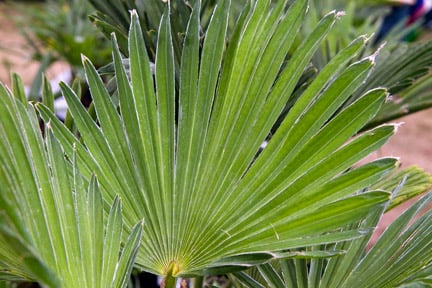
Quick facts
Common name - Hardy palms
Botanical name - Various Chamaerops, Jubaea, Trachycarpus
Group - Trees
Flowering time - Summer
Planting time - Early spring
Height and spread - 2-7m (6½-21ft)
Aspect - Sheltered, sunny
Hardiness - Hardy in mild regions
Difficulty - Moderate
Cultivation notes
Some hardy palms will survive winters in much of lowland Britain in sheltered gardens with favourable local conditions. However, plants that are in exposed positions, in containers or wet at the roots will be more liable to winter damage. As a result, the temperatures quoted are a general guide only – and the term hardiness is applied to mature specimens as young plants are more liable to being damaged by cold weather.
See also our page on palms for indoors.
- Palms can be grown in containers of John Innes No 3
- Hardy palms that will be planted out in the garden should initially be grown in containers and brought under cover (ideally into a frost-free greenhouse) during winter until well rooted in at least a five litre pot
- Plant in mid-spring to allow time for the palm to establish before winter. Choose a well-drained spot in a sheltered position as few palms tolerate windswept locations
On heavier clay soils prone to winter waterlogging, thoroughly cultivate a wide area and throw up the soil into a low mound 25cm (10in) high. Planting into the centre of this mound will keep at least some of the roots above the saturated soil in winter.
Palms grow slowly and need adequate space as they do not compete well with surrounding plants and most are not tolerant of shading.
Water and feed as for other trees.
Winter protection
As the palm stems thicken with age, the plants become more tolerant of lower temperatures. Prolonged winter frosts and cold winds damage leaves and may kill the central growing point. Where cold winters occur, prepare plants with a protective wrapping.
Palms grown in containers should also be protected or brought under cover for the winter. Where containers are left outdoors, ensure the pot is bubble-wrapped to prevent frost damage to the roots.
Pruning and training
Unlike other trees, palms cannot be pruned. However, unsightly dead lower leaves can be removed; but do not cut them back flush with the trunk.
Propagation
Palms are propagated by seeds. Seed should be planted to its own depth in any moist proprietary potting medium that both retains moisture and is free-draining. Place seed pots in a for the best results.
Older seed may not germinate well. Fresh seed can sprout within a week or two, but most species take two or three months to germinate, and some take up to two years.
Some palms, such as Chamaerops, can be increased by dividing the suckers.
Cultivar selection
For more ideas on choosing palms for the garden, see our Find a Plant tool.
Chamaerops humilis (dwarf fan palm) AGM: Forms clumps of fan-shaped leaves, up to to 2m (6½ft) tall. It is wind resistant and will tolerate -12°C (10°F) or lower. It is suitable for heavier clay soils and partial shade. C. humilis var. argentea from the Atlas Mountains in Morocco has attractive silvery-blue leaves.
Brahea armata (Mexican blue palm): Attractive, slow-growing fan palm with stiff pale blue leaves. Hardy to about -8°C (18°F) in a well-drained, sheltered sunny spot.
Butia capitata (jelly palm): Relatively slow growing with attractive arching green-blue leaves. One of the hardiest feather palms, it can be grown outdoors in sheltered gardens where it may tolerate -10°C (14°F). It is also suitable for heavier clay soils.
Jubaea chilensis (Chilean wine palm): Hardy to about -14°C (7°F), but it will not tolerate cold, windy situations. In mild areas, it can develop an erect trunk to about 5m (16ft) but is very slow growing.
Phoenix canariensis AGM (Canary Island date palm): Hardy to -8°C (18°F). A relatively fast-growing feather palm for a sunny, well-drained spot.
Rhapidophyllum hystrix (needle palm): Very cold tolerant fan palm to -15°C (5°F), but it requires hot summers. Very slow growing; eventually forming clumps of attractive deep-green leaves to 1m (3¼ft). Most suitable in sheltered south- or west-facing positions.
Sabal minor (dwarf palmetto): Slow, low-growing fan palm to 60cm (2ft) with large stiff blue-green leaves. Cold tolerant to -12°C (10°F), but requires hot summers. Most suitable in a sheltered well-lit south- or west-facing position.
Trachycarpus fortunei (Chusan palm) AGM: Large fan-shaped leaves. Good rate of growth. Withstands temperatures of -15°C (5°F) or below if sheltered. This is the one species of palm that can be grown widely in the UK, though the leaves may be damaged by high winds in cold, northerly, exposed sites. It is tolerant of heavier clay soils and some shade. The closely related T. wagnerianus has stiffer, more wind tolerant leaves. T. latisectus from north-east India and has broad, glossy, dark green leaves. Both appear as hardy as the Chusan palm.
Trithrinax campestris (Caranday palm): Fan-shaped, blue-green, wind resistant leaves. Slow growing; the trunk may grow to 5m (16ft). Very hardy to about -12°C (10°F). Easy to grow.
Washingtonia filifera (Washington palm): Tall fan-palm, fast growing and not suitable for a small garden. Probably only cold hardy to -5°C (23°F) and not suitable for windy gardens as the leaves are easily damaged.
Problems
If winter damage occurs, remove damaged growth in the spring and maintain good growing conditions to aid recovery.
Unfortunately, true palms such as these have only one growing point (at the top) so when this is killed the palm is unable to regrow from lower down (unlike cordylines). If recovery does not occur before late summer, the plant will probably have to be replaced.

